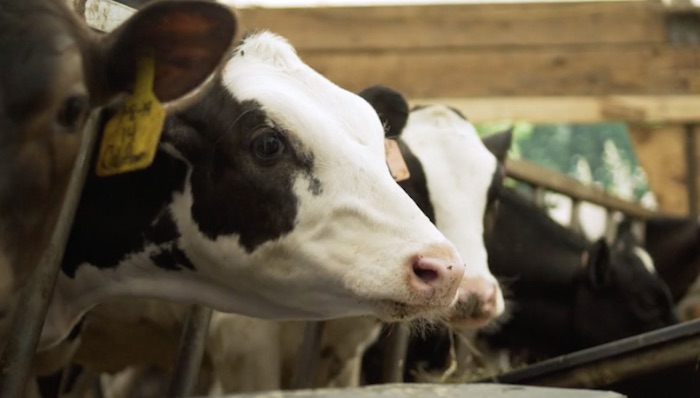
The move against “Big Dairy” is being linked to the U.S. Clean Air Act; the new petition blames large dairy operations for greenhouse gas pollution from biomethane, that is, flatulence-derived cow gas.
Editor’s note: This article is by Lou Varricchio, editor of the Sun. It is republished here with permission.
Vermont dairy farmers have been struggling economically for decades. Suppressed milk prices, as well as giant midwest and west coast farms, have threatened smaller family-run farms nearly everywhere.
Now comes a call by the Sierra Club, and its Vermont chapter, along with the organization’s other state chapters, to petition the White House to regulate emissions by dairy farms with 500 or more cows.
“As the threat of climate disruption becomes increasingly urgent, it makes sense that every source of greenhouse gas emissions should come under scrutiny. Both the reckless burning of fossil fuels and unsustainable agricultural practices are major contributors to greenhouse gas emissions,” said Sierra Club Deputy Director Bruce Hamilton earlier this month. “The single greatest source of agricultural greenhouse gas emissions is livestock, particularly factory-raised animals. Cattle… are responsible for about two-thirds of livestock emissions.”
Over 20 other environmental groups have joined the Sierra Club by signing the petition.
The move against “Big Dairy” is being linked to the U.S. Clean Air Act; the new petition blames large dairy operations for greenhouse gas pollution from biomethane, that is, flatulence-derived cow gas.
Several Vermont farms would be affected by any new rules enacted, according to Vermont’s Sierra Club chapter officials.
The Dubois farm, located on Route 17 in Addison, has over 2,000 cows. Perhaps the owners may already see the writing on the wall? Addison County’s largest farm is currently for sale online for over $19 million, listed by Carl Cole Realty in Vergennes.
Another “Big Dairy” operation is Pleasant Valley Farms in Berkshire with over 4,000 head.
In 2018, according to Vermont Daily online, 34 farms milked 700 or more cows.
“The National Sierra Club had signed on to the letter and whenever our national club takes a position it speaks for all chapters,” Robb Kidd, Vermont chapter conservation program manager, told Vermont Daily last week.
Local cattle rancher and state Rep. Harvey Smith (R) isn’t surprised that the Sierra Club has asked the Environmental Protection Agency to cut dairy farm methane emissions.
Representative Smith operates an all-natural beef operation on Lime Kiln Road in New Haven.
Smith appeared resigned to the Sierra Club’s proposal, but he suggested, lawmakers should take into account that local farmers are already doing a lot to share the burden in climate-change-related carbon reduction.
“I would like to point out a few observations that will make the agricultural community a team player in any carbon-reduction goals,” Smith told The Sun-Eagle. “The agricultural community understands that it needs to be part of the solution if a state or national carbon-reduction plan is to be successful.
“Farmers are currently using cover crops to meet the water quality goals by reducing nutrient loss and soil erosion. These same practices also sequester carbon by drawing down carbon from the air and storing it in the soil,” he said.
Smith said many farms in Vermont are already using or are planning to use methane digesters to generate green electricity for thousands of homes.
The Goodrich farm in Salisbury is currently completing work on a state-of-the-art methane operation to provide biogas to Middlebury College (to meet its carbon-reduction goals) as well as neighbors along the gas pipeline right-of-way.
“Vermont farmers are very proud of the role they play in food production,” Smith said. “They are keeping our working land open and productive for both residents and visitors to enjoy; they also provide habitat for a wide variety of plants, animals, fish, and birds. Farmers also provide places for people to enjoy their outdoor interests and helping to improve our air and water quality.”
Smith said farmers take great pride in being good stewards of the land.
But what remains to be seen is whether regulators in Washington, D.C., appreciate what dairy farmers are already doing to address human-induced climate change.



As the self anointed experts have their minions switching between the religions of Climate change, Systemic Racism and COVID 19 – I’m very curious as to what John Kerry is thinking when he speaks of the need to eliminate all CO2 from the atmosphere. His “settled science” is quite a bit different from reality. My memory of grade school science is that plants take in CO2 and release oxygen. When, Mr Kerry did this change?
For those that worship the climate religion, ponder this: No CO2, no plants. No plants, no food. No food, no climate worshippers. For millennia, all terrestrial life has required an atmosphere of 78% nitrogen, 21% oxygen and 1% everything else. You and your climate hero aren’t going to change that,ever.
Those idiots in the sierra club have no idea that the Ben & Jerry’s that they are eating comes from dairy farms. When you take into consideration that there are people out there that voted AOC into office, then there has to be other morons ready to follow other moron (experts) with their idiotic plans.
On the word of Fauci and the Joke in the Presidents chair I would recommend
masking up the cows on both ends to lower methane output.. seems like a inexpensive alternative to what ever the gov comes up with. Maybe even double
up on the rear mask….
I realize that this global crisis has reached well beyond my ability to even engage in the discussion and it’s so immanent that there’s not time to try to convince the doubters. We’re supposed to relinquish the arenas to the “experts” and our government over seers. But in my limited understanding, the issue is releasing too much carbon into the atmosphere…right? Does this mean we will be looking for a reduction in our exhaling? Asking for a friend.